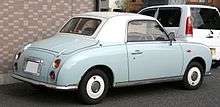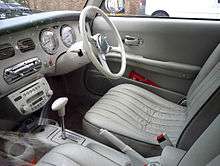Nissan Figaro
| Nissan Figaro (E-FK10) | |
|---|---|
_convertible_(26452674766).jpg) | |
| Overview | |
| Manufacturer | Nissan |
| Production | 1991 |
| Assembly | Oppama Plant, Yokosuka, Kanagawa, Japan |
| Designer | Naoki Sakai and Shoji Takahashi |
| Body and chassis | |
| Class | City car |
| Body style | 2-door convertible |
| Layout | FF layout |
| Platform | Nissan B platform |
| Related | |
| Powertrain | |
| Engine | 987 cc MA10ET I4 turbo |
| Transmission | 3-speed automatic |
| Dimensions | |
| Wheelbase | 2,300 mm (91 in) |
| Length | 3,740 mm (147 in) |
| Width | 1,630 mm (64 in) |
| Height | 1,365 mm (53.7 in) |
| Curb weight | 810 kg (1,790 lb) |
The Nissan Figaro is a two-door 2+2 retro-styled fixed-profile convertible manufactured by Nissan for model year 1991, and originally marketed solely in Japan at their Nissan Cherry Stores.
With its design variously attributed to Naoki Sakai[1] and/or Shoji Takahashi,[2] twenty thousand examples were marketed by Nissan in the convertible's single year of production[3] — all with right hand drive.[4]
Because of its origins at Pike Factory, Nissan's special project group, the Figaro — along with the Nissan Pao, Be-1 and S-Cargo — are known as Nissan's "Pike cars."
In 2011, noted design critic Phil Patton, writing for the New York Times, called the Pike cars "the height of postmodernism"[2] and "unabashedly retro, promiscuously combining elements of the Citroën 2CV, Renault 4, Mini [and] Fiat 500."[2]
Overview
The Figaro was introduced at the 1989 Tokyo Motor Show under the slogan "Back to the Future". The name references the title character in the play The Marriage of Figaro by Pierre Beaumarchais.
Based on the Nissan Micra, the Figaro was built at Aichi Machine Industry,[1] a special projects group which Nissan would later call "Pike Factory," which also produced three other niche automobiles: the Be-1, Pao and S-Cargo.
As a fixed-profile convertible, the upper side elements of the Figaro's bodywork remain fixed, while its fabric soft top retracts to provide a less fully open experience than a typical convertible. The fixed-profile concept is seen on other convertibles, including the Citroën 2CV (1948–1990), the Nash Rambler Convertible "Landau" Coupe (1950), and the 1957 Fiat 500 — as well its 2007 Fiat 500 successor.
The Figaro was marketed in four colours representing the four seasons: Topaz Mist (Autumn), Emerald Green (Spring), Pale Aqua (Summer) and Lapis Grey (Winter). Few, reportedly 2,000, were marketed in Topaz Mist.
The Figaro was equipped with leather seats, air conditioning, CD player and a fixed-profile slide-back open roof.
8000 were originally available with an additional 12,000 added to production numbers to meet demand. Prospective purchasers entered a lottery to purchase a Figaro. Limited edition cars came with passenger side baskets and cup holders.
Specifications


.jpg)
- Steering: Rack and pinion
- Suspension: Four-wheel independent
- Front: Strut-type
- Rear: 4-link,solid axle, with stabilizer bar (anti-sway bar)
- Front Wheel Drive
- Brakes: Power-assisted Ventilated front discs, rear drums
- Tire size: 165/70R12 77H Cold climate spec: 155SR12 (155/80R12)
- Weight
- Max laden weight: 1235 kg (2723 lb)
- Max rolling weight: 1835 kg (4045 lb)
- Max load (front axle): 620 kg (1367 lb)
- Max load (rear axle): 625 kg (1378 lb)
- Max trailer weight (without brakes): 310 kg (683 lb)
- Max trailer weight (with brakes): 600 kg (1323 lb)
- Performance
- Turning Circle (kerb to kerb): 4.7 m (15 ft 5 in)
- Fuel Economy: 7.3 L/100 km (39 mpg-imp; 32 mpg-US)
- Fuel consumption rate: 60 km/h (37 mph) running, on level ground: 4.1 L/100 km (69 mpg-imp; 57 mpg-US)
- Top Speed: 106 mph (170.59 km/h)
- Bhp Power: 60whp
- Engine
- Bore and Stroke: 68.0 mm × 68.0 mm (2.68 in × 2.68 in)
- Compression Ratio: 8.0:1
- Max Power: 76 PS (56 kW; 75 hp) at 6000 rpm
- Max Torque: 10.8 kg·m (106 N·m; 78 lb·ft) at 4400 rpm
- Fuel Delivery: ECCS
- Fuel Type/Capacity: Super Unleaded/40L (8.8 imp gal or 10.6 US gal)
- Features
- Three-point seat belts (no airbags)
- Rear seat: Three-point seat belts
- Driver's seat belt not fastened warning (buzzer)
- High-mount stop lamp
- Genuine leather seats standard equipment
- Low-mount head rest for classic appearance
- Synthetic leather piping
- Top
- Retractable fabric top with fixed-profile two-tone bodywork
- Top fully retracts into concealed nacelle.
- Top equipped with a double lock and warning buzzer as a safety feature
- Secondary hood latch
- Glass rear window with defrosters
- Body
- Flush mount apron and flush mount fender
- Glassfibre resin material with an outer gel coat atr front fenders and front grill surround
- Fluoroplastic paint
In popular culture
Sarah Jane Smith drove a mint green Nissan Figaro in the BBC spin-off television series of Doctor Who, The Sarah Jane Adventures.
Andrew Marr is seen driving a Figaro in the opening credits of the Sunday morning BBC One programme The Andrew Marr Show.[5]
The car has a brief cameo in Mako's flashback of a Kaiju attack on Tokyo in 2016, in the film Pacific Rim, where it can briefly be seen as a fleet of fighter jets fly above.
The car has a cameo in the Canadian Sci-Fi show, Continuum, season 1, episode 7.
In the Japanese TV drama Aibō, the lead detective drives one that is painted black and had driven the same car since the series began in 2000.
The YouTube show Mighty Car Mods bought a Figaro to replace The Blue Turd, but it lost in the Figaro vs The Blue Turd episode.
Pop star Marina and the Diamonds used a bluish/grey Figaro in the music video for her song Blue, from her third album Froot.
Noted Nissan Figaro owners, include FC Barcelona and Belgian footballer Thomas Vermaelen,[6] guitarist Eric Clapton, Canadian Tabla/Ghazal Wizard Cassius Khan, TV presenter Vanessa Feltz, and Princess Eugenie.[7] Mollie King, from British girl group The Saturdays is another owner. Mami Ayukawa purchased a Figaro new in 1991 and was driving it as of 2013.[8]
References
- 1 2 Brendan McAleer (July 28, 2015). "No matter how you slice it, the pint-sized Nissan Figaro is just plain fun". Driving.CA.
- 1 2 3 Phil Patton (March 18, 2011). "Nissan's Cartoon Cars, Once So Hip". The New York Times.
- ↑ A.J. Baime (April 19, 2016). "How a Nissan Figaro Became an Instant Classic in the U.S.". The Wall Street Journal.
- ↑ Jim Cherry (May 7, 2010). "1991 Nissan Figaro: Back to the future in Pee Wee Herman's dream car". The Examiner.com.
- ↑ The Andrew Marr Show - Frequently Asked Questions BBC One
- ↑ "Thomas Vermaelen urged to ditch his old banger by Arsenal captain Robin Van Persie". Metro.co.uk. Associated Newspapers Limited. 15 October 2011. Retrieved 19 October 2011.
- ↑ Toby Brooks, Origins of the Nissan Figaro, The Figaro Shop
- ↑ My Friend "FIGARO" mami's talking
| Wikimedia Commons has media related to Nissan Figaro. |
External links
- Figaro Owners Club Facebook Page
- Figaro Owners Club
- Figaro Owners Club Forum}
- Figaro Owners Club YouTube Channel}